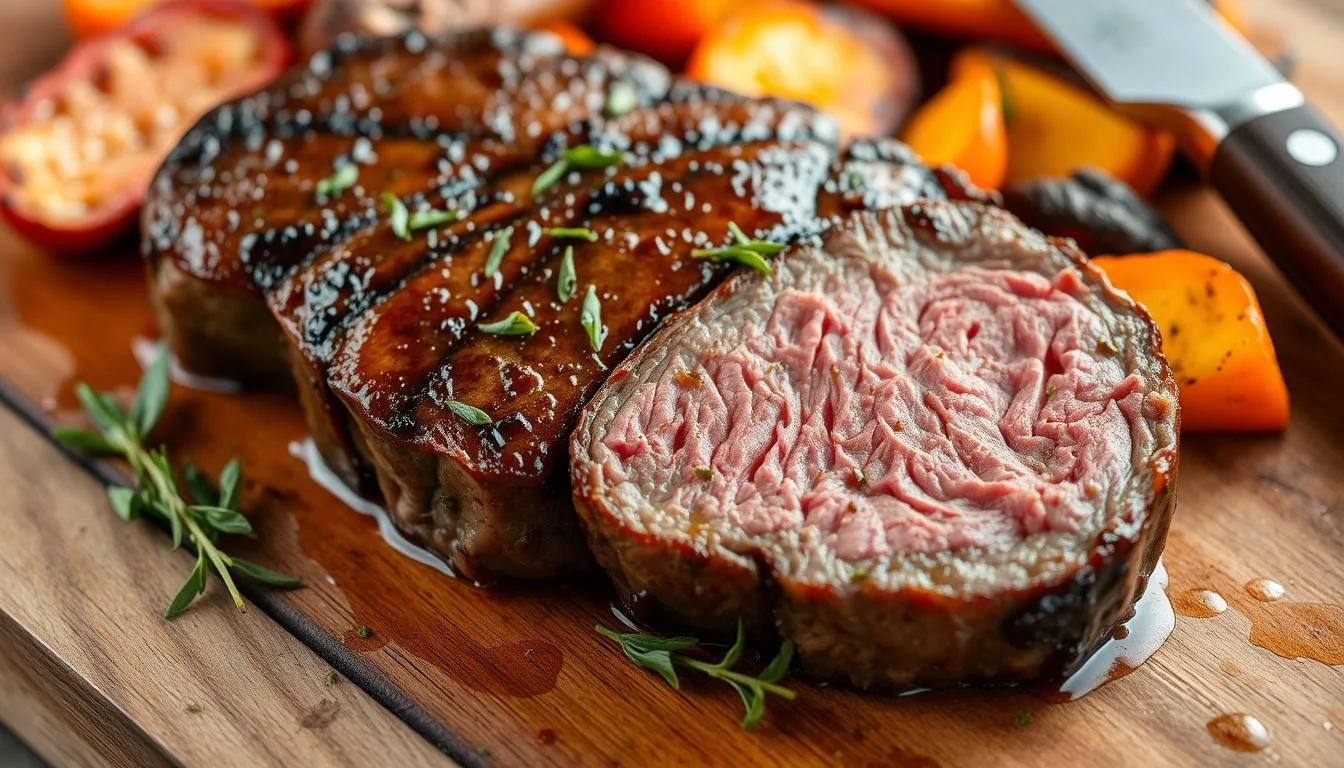Delicious Beef Tenderloin: A Juicy, Tender Delight
The first time I sliced into a perfectly cooked tenderloin, I knew why it’s called culinary royalty. The moment of anticipation is thrilling. Watching the knife glide through the meat, revealing a perfect rosy center, makes dinner special.
Beef tenderloin is more than just another steak. It’s the top choice for its incredible softness and rich flavor. Whether it’s for a special occasion or a treat for yourself, this guide will help you. You’ll learn how to pick, prepare, and cook the best beef tenderloin.
Starting your journey to master this cut is exciting. With the right techniques, you’ll make a dish that’s unforgettable. It will be a culinary adventure that your guests will love and ask for more.
Table of Contents
Understanding Beef Tenderloin: The Crown Jewel of Beef Cuts
The beef tenderloin is the top choice for chefs and meat lovers. It’s known for its tender texture and rich flavor. This makes it a favorite in the world of food.

Anatomy of the Tenderloin Cut
The beef loin is found along the cow’s spine. It’s a muscle that doesn’t move much, making it very soft. This muscle is under the ribs and is highly sought after.
- Length: Typically 18-24 inches long
- Weight: Approximately 4-5 pounds per cow
- Muscle: Psoas major muscle
Why This Cut Commands Premium Prices
The filet mignon is expensive for good reasons. It’s a small part of the cow, making it rare and hard to get.
| Factor | Impact on Price |
|---|---|
| Rarity | Limited supply per cow |
| Tenderness | Minimal muscle usage |
| Versatility | Multiple culinary applications |
Different Names Around the World
The chateaubriand cut has many names worldwide. Each name reflects the local cooking traditions.
“The tenderloin is not just a cut of meat, it’s a culinary canvas waiting to be transformed.” – Chef Michael Roberts
It’s known as filet mignon in France, chateaubriand in fancy cooking, or beef tenderloin in the US. It’s a sign of fine dining everywhere.
Essential Tools and Equipment for Perfect Tenderloin Preparation
Preparing top-notch beef tenderloin recipes needs more than skill—it requires the right kitchen tools. Both professional chefs and home cooks know that quality tools can turn a simple meal into a memorable culinary experience.
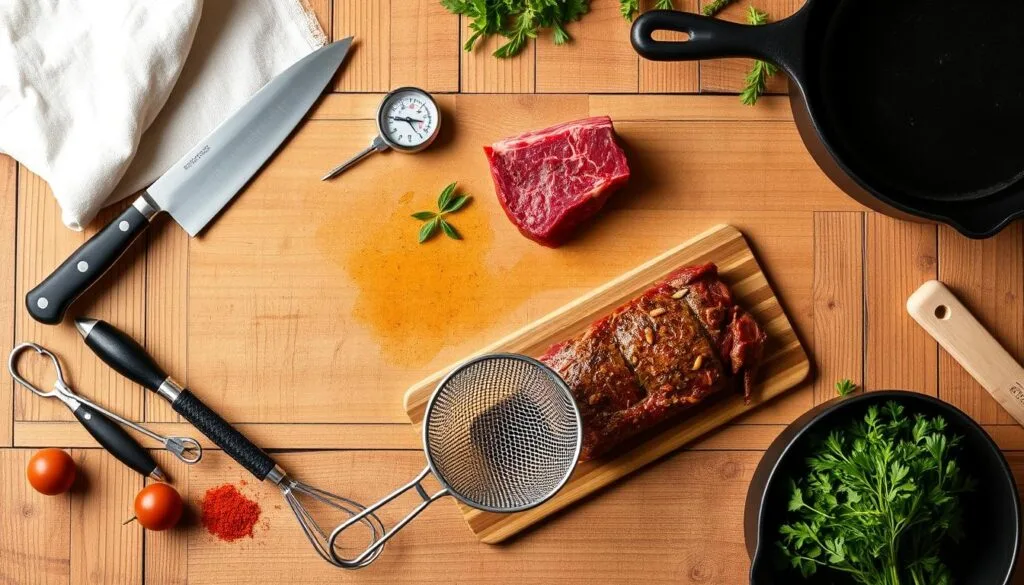
When you start with tenderloin recipes, you’ll need a few key tools:
- Sharp chef’s knife for precise trimming
- Sturdy cutting board with non-slip surface
- Digital meat thermometer
- Heavy-duty roasting pan
- Kitchen twine for trussing
Precision is key when working with premium beef tenderloin. A top-notch digital meat thermometer is essential for perfect doneness. Choose models with instant-read features and temperature guides for various cooking levels.
“The right tools are like a chef’s secret weapon in creating memorable tenderloin recipes.” – Culinary Expert
Your roasting pan should be strong and big enough for the tenderloin without overcrowding. Stainless steel or cast-iron pans spread heat evenly. This helps you get a beautiful golden-brown outside while keeping the meat juicy inside.
Invest in top-quality kitchen tools to take your beef tenderloin recipes from good to great. Remember, professional-grade equipment doesn’t just make cooking easier—it makes it more fun.
Selecting Premium Beef Tenderloin at Your Butcher
Choosing the perfect beef tenderloin is all about knowledge and careful selection. Your success in the kitchen begins with picking the best tender beef steak at the butcher shop.
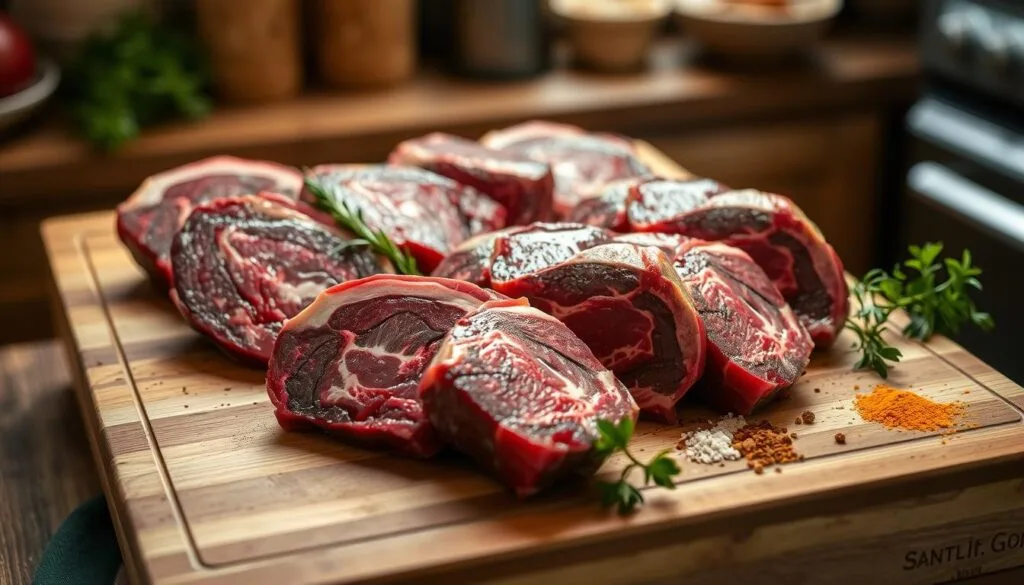
When you’re looking for beef tenderloin, several important factors affect its quality. Both professional chefs and home cooks know that the right piece makes a big difference in your dish.
Grading Systems and Quality Markers
USDA beef grading gives you key insights into meat quality. You’ll mainly see:
- Prime: Highest quality with lots of marbling
- Choice: High-quality beef with good marbling
- Select: Leaner cut with less fat
Size and Portion Guidelines
| Number of People | Recommended Beef Tenderloin Weight |
|---|---|
| 2-3 people | 2-3 pounds |
| 4-6 people | 4-5 pounds |
| 8-10 people | 6-7 pounds |
Fresh vs. Aged Considerations
Choosing between fresh and aged beef tenderloin changes the flavor and texture. Aged beef has more intense flavors because of controlled moisture loss and enzymatic breakdown.
“The secret to an extraordinary meal is selecting the right cut of beef tenderloin.” – Professional Chef
Your butcher can help you with these choices. Look for a bright red color, minimal moisture in the packaging, and consistent marbling for the best experience.
Master the Art of Trimming and Tying Your Tenderloin
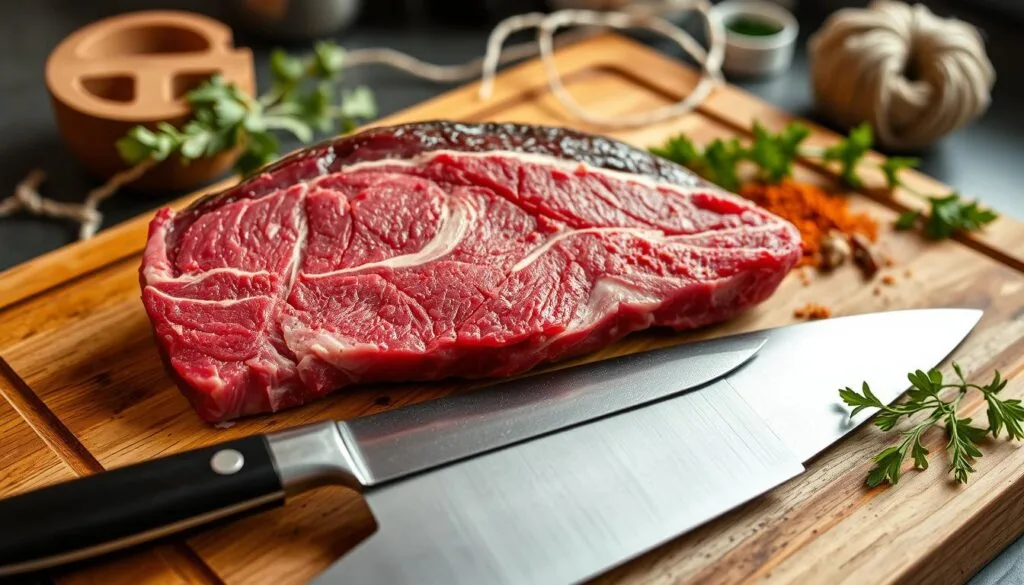
Preparing a tenderloin needs precision and skill. Professional chefs know that trimming and tying make a big difference. These steps turn an ordinary cut into a culinary masterpiece. They ensure your filet mignon cooks evenly and looks great on the plate.
“The difference between a good and great beef tenderloin is in the preparation.” – Culinary Expert
When working with beef tenderloin, focus on two key steps: trimming and tying.
Trimming Techniques
- Remove the silver skin using a sharp boning knife
- Trim excess fat carefully without removing too much
- Cut away any uneven sections for uniform cooking
The silver skin is a tough membrane that doesn’t break down during cooking. Removing it prevents chewy, unpleasant texture in your filet mignon.
Tying Methods
- Use butcher’s twine at 1-2 inch intervals
- Ensure consistent tension when wrapping
- Create a compact, uniform shape
Tying your beef tenderloin helps maintain its shape during cooking. This promotes even heat distribution and a beautiful presentation.
| Trimming Tool | Purpose | Recommended Type |
|---|---|---|
| Boning Knife | Precise silver skin removal | 6-inch flexible blade |
| Butcher’s Twine | Securing meat shape | 100% cotton, food-grade |
| Cutting Board | Safe meat preparation surface | Large wooden or plastic board |
Pro tip: Always work on a clean, stable surface and use sharp, high-quality tools for the best results with your beef tenderloin.
Ultimate Beef Tenderloin Marinade Guide
Turning your beef tenderloin into a masterpiece starts with the right marinade. A great marinade boosts the meat’s flavor, makes it tender, and makes your meal unforgettable.
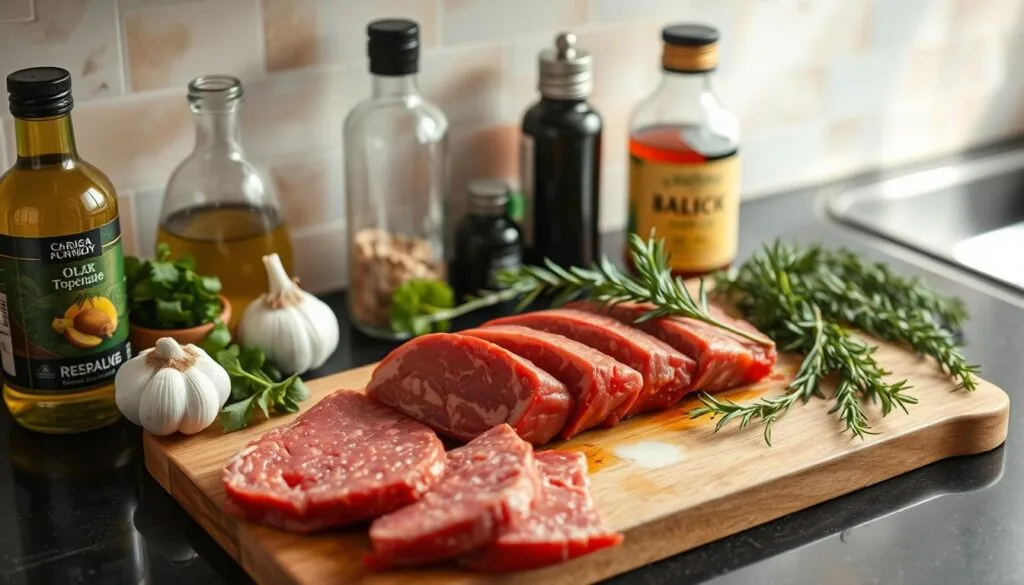
Marinades add amazing depth and complexity to meat. The trick is finding the perfect mix of ingredients and techniques.
Classic Marinade Combinations
Choosing the right ingredients is key to a perfect beef marinade. Here are some top picks:
- Red Wine & Herb Marinade
- Garlic & Rosemary Infusion
- Balsamic & Dijon Blend
Dry Rub Alternatives
Dry rubs are a great choice if you don’t like liquid marinades. They add flavor and keep the meat juicy.
| Dry Rub Type | Key Ingredients | Flavor Profile |
|---|---|---|
| Classic Steak Rub | Kosher salt, black pepper, garlic powder | Bold & Traditional |
| Smoky Southwest | Smoked paprika, cumin, chili powder | Spicy & Robust |
| Herb Garden | Dried thyme, rosemary, oregano | Fresh & Aromatic |
Optimal Marinating Times
Marinating time is important for your beef tenderloin. Too long can make it tough, too short and it won’t taste as good.
“Patience is the secret ingredient in creating the perfect marinated beef tenderloin.” – Professional Chef
- Minimum Time: 30 minutes
- Ideal Time: 2-4 hours
- Maximum Time: 8 hours
Remember, high-quality beef needs care. Your marinade should bring out the meat’s natural flavors, not hide them.
Cooking Methods: From Grill to Oven
Mastering different cooking techniques is key to a perfect beef tenderloin. You can choose between a grilled tenderloin with char marks or a roasted one with a golden crust. Each method brings its own flavors and textures.

Choosing the right cooking method can make your pan-seared beef amazing. Let’s look at three main techniques to improve your cooking:
- Grilling: High heat, quick cooking
- Pan-searing: Crispy exterior, juicy interior
- Roasting: Even, consistent temperature
Grilling Techniques
Grilling a beef needs careful temperature control. Heat your grill to medium-high (400-450°F). Make sure to have both direct and indirect heat zones.
Pan-Searing Magic
For pan-searing, use a cast-iron skillet and high smoke point oil. Sear each side for 2-3 minutes to get a rich, caramelized crust.
Roasting Perfection
Roasting a beef tenderloin requires a steady oven temperature. Preheat to 425°F and use a meat thermometer to check the internal temperature.
| Cooking Method | Temperature | Cooking Time |
|---|---|---|
| Grilling | 400-450°F | 10-15 minutes |
| Pan-Searing | Medium-high | 6-8 minutes |
| Roasting | 425°F | 20-25 minutes |
“The secret to a perfect tenderloin is respecting the meat’s natural qualities and cooking it with precision.” – Professional Chef
Each method has its own benefits. Your choice depends on what you like, what you have, and the flavor you want.
Temperature Guide for Perfect Doneness
Getting the right temperature is key when cooking beef tenderloin. The perfect doneness of your tender beef steak depends on the internal temperature and how you cook it.
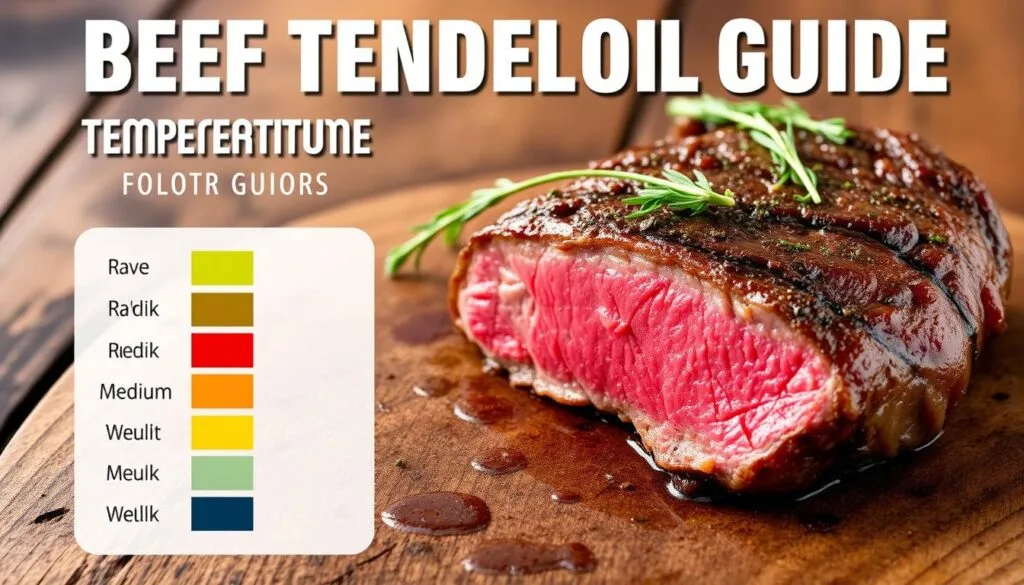
Knowing about meat temperatures is important. It helps you cook your beef tenderloin just the way you like it. Each level of doneness needs a specific internal temperature.
Internal Temperature Chart for Beef Tenderloin
| Doneness Level | Internal Temperature | Texture Description |
|---|---|---|
| Rare | 125°F | Cool red center |
| Medium Rare | 135°F | Warm red center |
| Medium | 145°F | Pink center |
| Medium Well | 150°F | Slight pink center |
| Well Done | 160°F | No pink |
Resting Time Recommendations
Letting your beef rest is key to keeping it juicy. Here’s what to do:
- Small roasts (2-3 pounds): Rest 10-15 minutes
- Large roasts (4-5 pounds): Rest 15-20 minutes
- Cover with aluminum foil during resting
Using Meat Thermometers Correctly
Get a reliable digital meat thermometer for accurate readings. Put the probe in the thickest part of your steak, away from fat or bone. Always clean your thermometer to avoid cross-contamination.
“Temperature is the secret to a perfectly cooked beef.” – Professional Chef
Pro tip: Take your beef off the heat 5-10 degrees before your desired temperature. It will keep cooking while it rests.
Side dishes should balance the tenderloin’s richness. They should also add texture contrast. Classic accompaniments include:
- Roasted garlic mashed potatoes
- Grilled asparagus with lemon zest
- Caramelized root vegetables
- Wild mushroom risotto
“The right side dish can transform a good beef tenderloin recipe into an unforgettable dining experience.” – Professional Chef
To complete your meal, mix sides with different textures and flavors. Creamy, crisp, and herb-infused dishes pair well with the tender meat.
Storing and Reheating Leftover Tenderloin
Keeping your beef tenderloin fresh after the first meal is key. Leftover beef tenderloin can be a tasty second-day meal if stored and reheated right.
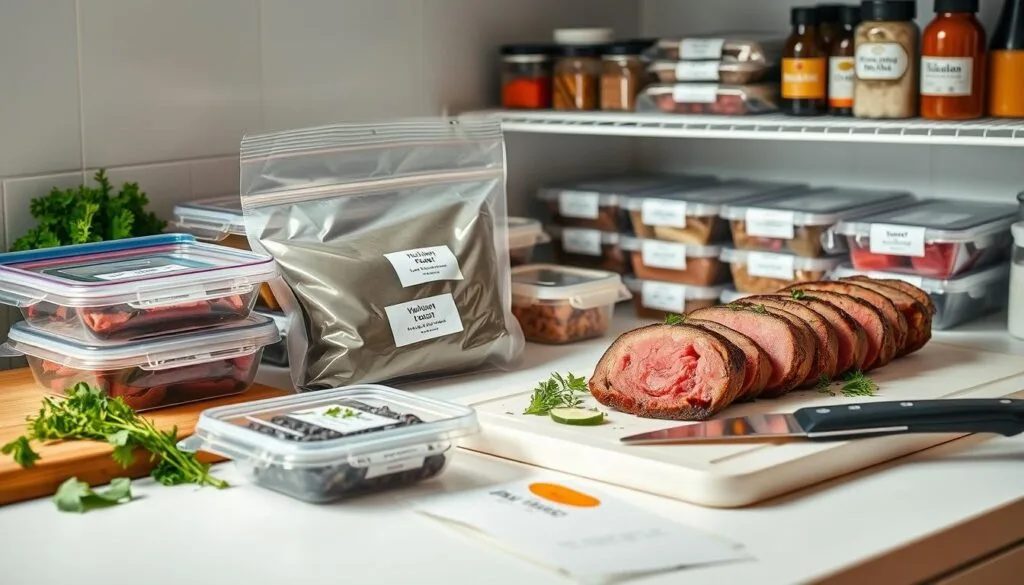
Proper Storage Methods
Start by storing your beef tenderloin wisely to keep its flavor and texture. Here are some important tips:
- Wrap the beef tenderloin tightly in aluminum foil or plastic wrap
- Store in an airtight container to prevent moisture loss
- Refrigerate within two hours of cooking
- Consume refrigerated beef tenderloin within 3-4 days
Reheating Without Overcooking
When reheating beef tenderloin, be gentle to keep it tender. High heat can dry out the meat.
| Reheating Method | Temperature | Recommended Time |
|---|---|---|
| Oven | 275°F | 10-15 minutes |
| Microwave | 50% power | 30-45 seconds |
| Skillet | Low heat | 2-3 minutes per side |
“The key to perfect leftover beef is low and slow reheating to maintain its original juiciness.” – Professional Chef
Pro tip: Always use a meat thermometer. This ensures your beef tenderloin reaches a safe internal temperature of 165°F when reheating. It keeps the meat safe and tender.
Conclusion
Learning to cook a tender beef steak takes time and effort. It’s all about mastering the right techniques. By choosing the best cuts and cooking them just right, you can make any meal special.
Using the tips from this guide will make you a better cook. You’ll learn how to pick the best cuts and cook them perfectly. This will make your beef tenderloin dishes a hit with everyone.
Great cooking is about passion and paying attention to details. Whether it’s for a special dinner or a casual meal, your skills will shine. You’ll make delicious beef tenderloin dishes that impress.
Start your journey to becoming a beef expert. With practice, you’ll get better at controlling temperatures and seasoning. You’ll learn to turn a premium cut into a memorable meal.

